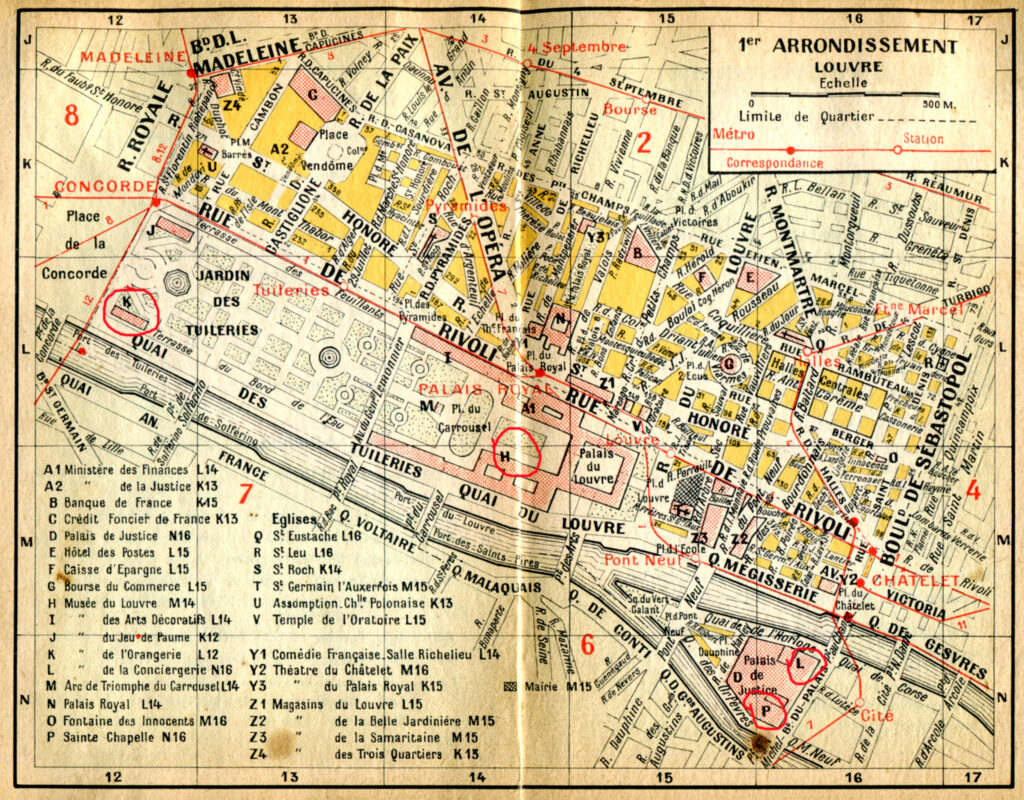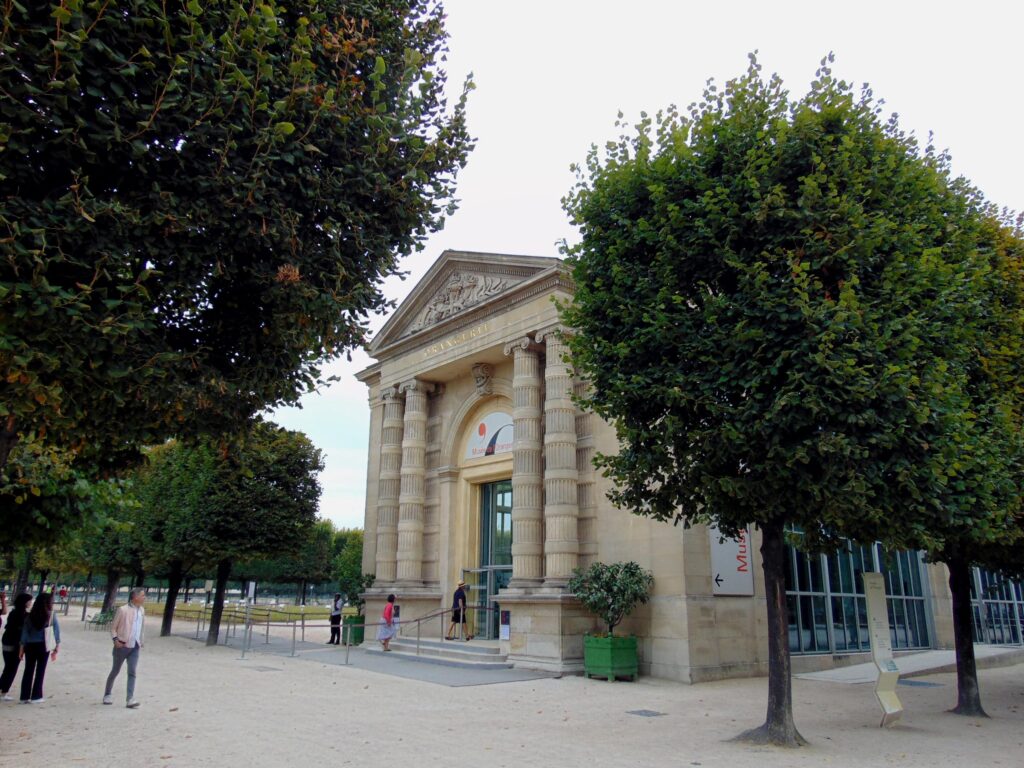Orangerie Museum Paris mini tour guide in English.
Located in the Tuileries Gardens, in the heart of Paris near the Place de la Concorde, the Museum contains an interesting collection of paintings spread over three floors. The upper or “zero” level includes several rooms where large works by Claude Monet from the “water lilies” series are located on the walls. On the minus second level there are several halls of works by various artists, including Soutine. The main collection of paintings in the permanent exhibition of the museum, in addition to works by Claude Monet, contains more than 140 works by famous masters Gauguin, Renoir, Cezanne, Picasso and Modigliani
A little about the Orangerie Museum
From the Second Empire to the Water Lilies, the building did not always display works of art. Sometime in 1852 it was built as a real “Orangerie”, a winter refuge for orange trees in the garden of the Tuileries Palace. Previously, orange trees were located in the Grand Gallery of the Louvre. At the request of Emperor Napoleon III, the new structure was built on a garden terrace along the Seine, known as the “quay terrace”, in a record time of four months and according to plans drawn up by the architect Firmin Bourgeois (1786 -1853). The structure is very similar to a greenhouse: its southern façade faces the river and is made of glass to let in sunlight and heat. The opposite façade, facing the Rue de Rivoli, is almost completely windowless to avoid northerly winds. The main entrances are located on both sides, west and east, and were decorated by Louis Visconti (Louis Visconti 1791-1853), the architect in charge of renovations at the Louvre. The doorways, framed by columns, reflect the design of the Tuileries Palace. They are topped by triangular pediments sculpted by Charles Gallois-Poignant, representing a cornucopia, plants and ears of corn in relation to the function of the site. After the fall of the Empire in 1870 and the fire at the Tuileries Palace in 1871, the Orangerie became the property of the state. It continued to be used for storing orange trees and for holding various events: horticultural, music and art exhibitions, banquets, competitions, exhibitions, etc. until 1922.
Installation of Water lilies
After the First World War, a new fate brought about radical changes in the Orangerie. Indeed, in 1921 the state handed over the building, built in 1862 on a terrace parallel to Rivoli Street. for the vice-secretariat of the State for Fine Arts, as well as his colleague Jeu de Paume. The idea was to provide space for live artists to show their work. It was at this point that the president of the Council, Georges Clemenceau (Georges Clemenceau 1841-1929), suggested that the large “Water Lilies” that Claude Monet (1840-1926) was painting at the time and which he donated to the state should be installed here. The works were installed in the Orangerie, not in the courtyard of the new Musée Rodin. The donation was made in 1922.
Claude Monet spent much of his time working on architectural design with the architect Camille Lefèvre (1876-1946). In the end, 8 panels 2 meters high and a total length of 91 meters were located in 2 oval rooms that form the symbol of infinity. Their east-west orientation places them in the path of the sun and along the historical axis of Paris, running from the Arc de Triomphe to the Louvre. The hallway provides access to two rooms and marks the transition from the outside world. Finally, the natural light that enters, although the ceiling immerses visitors in a state of grace, just as the artist intended.
The Claude Monet Museum was opened by Clemenceau on May 17, 1927, a few months after the artist’s death. It was converted into an annex of the Luxembourg Museum and the building became the Tuileries National Museum.
Major exhibitions at the Musée de l’Orangerie from the 1930s to the 1950s
In 1930, the Musée National des Arts de l’Orangerie at the Tuileries was attached to the Louvre. The western half of the building, next to the Place de la Concorde, has been turned into a series of four rooms dedicated to temporary exhibitions of national museums, marking a new chapter in its history. A series of magnificent exhibitions were held every year: the Impressionist cycle from 1930 to 1933, the exhibition dedicated to the 17th century of “Peintres de la réalité” (naturalist painters) in 1934, which became legendary, “Rubens et son temps” (Rubens and his time, which attracted a million visitors in 1936, and the Degas exhibition in 1937. In 1942, an exhibition was held dedicated to the German sculptor Arno Breker, who had studied in France and became the official Reich Here in 1946 masterpieces of French private collections found in Germany by the French Commission for the Search for Works of Art were presented, and the exhibition “Allies – Great People”.
In 1945, the Orangery, together with the Jeu de Paume, which housed the Louvre’s Impressionist collection, formed a single entity attached to the Louvre’s painting department. The “Réunion des Musées Nationaux” (Association of National Museums) continued to organize major exhibitions here from 1946 to 1960, which proved to be quite successful, such as “Van Gogh et les peintres d’Auvers-sur-Oise” (Van Gogh and the artists from Auvers-on-Oise) and “De David à Toulouse-Lautrec” (From David to Toulouse-Lautrec) in 1954 and 1955. All this led to the construction of the National Gallery in the Grand Palais, which opened in 1964.
Acquisition of the collection of Jean Walter and Paul Guillaume.
The state in 1959 and 1963 acquired the collections of Jean Walter (Jean Walter) and Paul Guillaume (Paul Guillaume), which finally formed the Musée de l’Orangerie. Indeed, Domenique Walter (Jean Walter 1898-1977), widow of the art dealer Paul Guillaume (1891-1934) and later of the architect and industrialist Jean Walter (1883-1957), fulfilled her first husband’s desire to create “the first museum of French modern art”, which would be open to the public. The state offered to exhibit the collection in the Orangery.
The second renovation project was led by architect Olivier Lahalle from 1960 to 1965. Galleries were added to the building as two underground levels were added along its entire length. A monumental railing staircase designed by Raymond Subes (1893-1970) replaced the water lily entrance vestibule. This led to the formation of a series of exhibition halls which were necessary for Domenica to display 146 paintings. The public presentation of the collection took place in 1966, which was opened by the Minister of Culture, André Malraux. Domenica kept the paintings until her death in 1977.
A third renovation project was carried out from 1978 to 1984 to strengthen the building, renovate the rooms and permanently maintain the entire collection under the name “Jean Walter and Paul Guillaume Collection” in accordance with Domenica’s wishes. The Orangerie thus became an independent national museum, separated from the administrative oversight of the Louvre and Che de Paum, whose Impressionist collections were destined for the future Musée d’Orsay.
2000-2006: new museum
The last reorganization of the Orangerie took place between 2000 and 2006 under the direction of the architect Olivier Brochet of the construction firm Brochet Lajus Pueyo. The rooms, built on two levels, were removed and natural light was restored in the Water Lilies room. Rooms were excavated at basement level in the north of the building to house the collection of Jean Walter and Paul Guillaume. Temporary exhibition spaces, an auditorium, an educational space and a library were also created. The work was delayed and altered by the discovery of the remains of the “yellow ditches” wall built from 1566 to protect the Tuileries Palace.
On May 17, 2006, the museum reopened and again adopted an ambitious exhibition policy. In May 2010, it was attached to the Musée d’Orsay as the “Public Institution of the Musée de l’Orangerie”.
The building is now surrounded by a number of sculptures. Along the northern facade, visitors can see works by Alain Kirili (born 1946) made since 1986: “Grand Commandement blanc” and three bronze works by Auguste Rodin (1840-1917): “Eve” (1881, cast around 1889 ), “Méditation avec bras” (1881, cast around 1905) and “L’Ombre” (1881, cast around 1904). In front of the entrance to the museum you can see the statue of Rodin “The Kiss”. Visitors arriving at the building from the opposite side of the entrance can see “Reclining Nude” (Reclining Nude), made in 1951 by Henry Moore (Henry Moore 1898-1986) at the foot of the stairs and “Le Lion au serpent” (Lion with a snake ) by the sculptor Antoine-Louis Barye (Antoine-Louis Barye 1796-1875) on the promenade terrace.
Collections of the Orangerie Museum, famous artists.
Some of the artist’s works presented in the halls.
Claude Monet
Pablo Picasso
Henri Matisse
Amedeo Clemente Modigliani
André Derain
Chaïm Soutine


